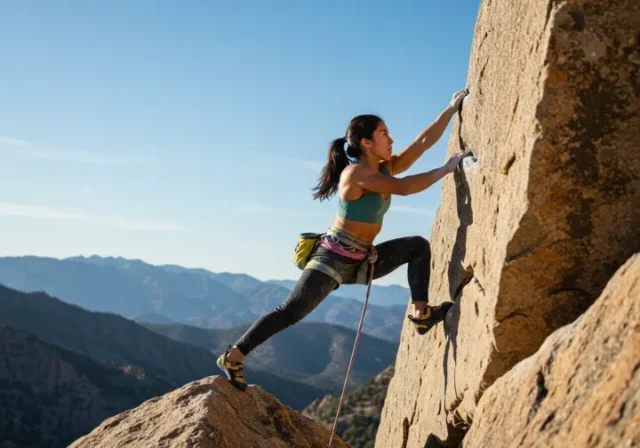In this article
Have you ever felt strong enough to hold a position statically, yet failed completely on a powerful, dynamic move? This common frustration highlights a fundamental concept in athletic training: the difference between strength and power. While related, they are not the same. True climbing progression requires understanding and developing both. Maximal strength is the absolute force you can generate, while power is the rate at which you can apply that force, a key concept in exercise science.
Think of it as the Strength-Power Pyramid. A wide, stable base of foundational strength is the prerequisite for building a high peak of explosive power. This article provides a comprehensive roadmap for building both. We will cover foundational strength training, delve into the science of explosive exercises, introduce the best training tools, and show you how to program a complete power and strength workout safely and effectively.
Building the Base: Foundational Strength Training for Climbers
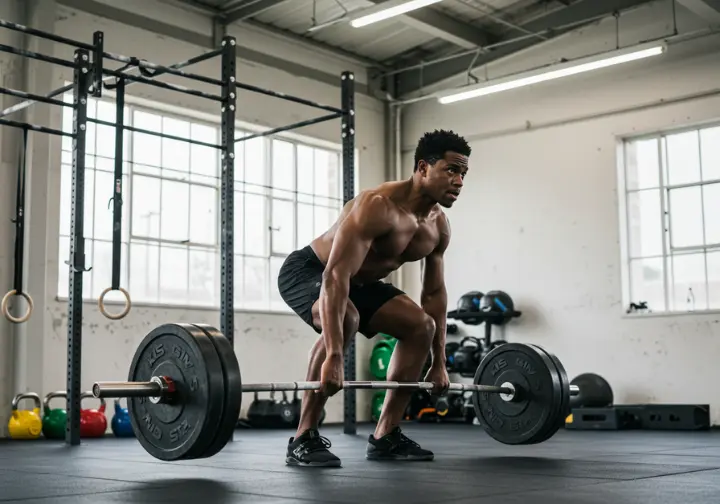
To generate the power that sends hard routes, you must first lay a solid groundwork of strength. We’ll cover the “what” and “how” of building this essential base that underpins all climbing movement. Our focus will be on key muscle groups and effective off-the-wall compound exercises. Throughout this section on strength and conditioning, we will emphasize the absolute importance of proper exercise form to ensure you build a resilient foundation for your climbing goals.
The “Big Lifts”: Why Climbers Need General Strength
While not climbing-specific, general strength exercises like deadlifts and squats are transformative for climbers. They build overall robustness, enhance the body’s ability to handle high training loads, and can even improve bone mineral density. This foundational strength creates a more resilient athlete, correcting muscular imbalances often caused by climbing and contributing directly to injury prevention. Truly, Targeted strength training is essential for climbers to build a higher capacity for sport-specific training.
The deadlift is often called the “king of exercises” for good reason. It develops the entire posterior chain—your glutes, hamstrings, and back. This is crucial for maintaining core tension on steep walls and executing powerful, leg-driven movements. When performing a conventional deadlift, focus on maintaining a neutral spine, engaging your lats to protect your back, and driving the movement with your legs. This form is non-negotiable for maximizing benefits from your weight training and minimizing injury risk.
Many climbers mistakenly neglect squats, but the leg strength they build is critical. Squats develop your ability to generate force from the feet, execute powerful rock-overs, and absorb the impact from falls. This contributes directly to both performance and safety. Variations like back squats are excellent for building maximal load, while goblet squats are a fantastic tool for teaching proper mechanics before adding heavy weight.
To see continuous strength gains, you must apply the principle of progressive overload. This means systematically increasing the training stress over time, whether by adding weight, reps, or sets. Without this, your body adapts, and progress will plateau. A consistent, gradual increase in challenge is what signals your body to get stronger, building the base needed for future power development. For those just starting, learning key lifts safely is the most important first step.
Essential Pushing and Pulling Power and Strength Exercises
Pull-ups and their variations are the cornerstone of climbing-specific pulling strength exercises. They directly train the latissimus dorsi and biceps, which are the primary engines for upward movement on the wall. You can vary your grip (wide, narrow, neutral) to change the muscular emphasis. To progress, you can add weight with a harness or work towards one-arm variations to build maximum strength and truly build climbing-specific strength.
Antagonist training is critical for muscular balance and injury prevention. Pushing exercises like the overhead press and bench press strengthen the chest, shoulders, and triceps, a vital part of any full body workout. This creates stability around the shoulder joint, which is highly prone to injury in climbers. A strong overhead press, for example, directly helps stabilize the shoulder during lock-offs and dynamic moves, making you a more robust athlete.
Rows—whether with a barbell, dumbbells, or rings—are a crucial complement to pull-ups. They build a strong, balanced back by targeting the rhomboids and mid-trapezius muscles differently than vertical pulling does. This focus promotes better posture and shoulder health, helping to counteract the “climber’s hunch” and ensuring your shoulder blades can retract and stabilize properly during complex movements.
For developing maximal muscle strength, exercises should be performed in lower repetition ranges, typically 3-5 reps per set, with high intensity. This type of training primarily improves the nervous system’s ability to recruit muscle fibers. The result is a significant gain in strength without necessarily adding large amounts of muscle mass, which is ideal for improving a climber’s strength-to-weight ratio. You can find a great list of ten off-the-wall exercises that follow these principles.
Building a Rock-Solid Core for Tension and Control
The “climber’s core” is much more than just the “six-pack” muscles. It is a 360-degree system that includes the abdominals, obliques, and lower back stabilizers. In climbing, its main job is to maintain body tension, especially on steep terrain. This tension allows force to be transferred efficiently from your feet to your hands. Without a strong core, your feet will swing away from the wall on overhangs, wasting precious energy.
Foundational core exercises like the plank and its variations (side planks, planks with arm or leg lifts) are excellent for building stability. When performing these, it is vital to maintain a perfectly straight line from your head to your heels to ensure proper engagement of the entire core. The isometric contraction workout builds the endurance needed to hold body tension through long, pumpy sequences, highlighting the critical but often overlooked role of a strong core.
Dynamic core exercises are highly specific to climbing movements. Hanging leg raises and their progressions, from bent knees to straight legs to toes-to-bar, are prime examples. These movements train the hip flexion and lower abdominals to lift the feet high and place them precisely on holds. This is a fundamental skill for efficient movement on steep walls, where every move counts.
To control your body during off-balance moves, rotational and anti-rotational exercises are vital. Russian twists and Pallof presses train your core to resist twisting forces, which is what you need to control a “barn-door” swing when your center of gravity is pulled away from the wall. This type of rotational stability is a hallmark of advanced climbing technique. For more ideas, Red Bull has a guide to core-focused workouts.
Unleashing Explosive Power: From Strength to Speed
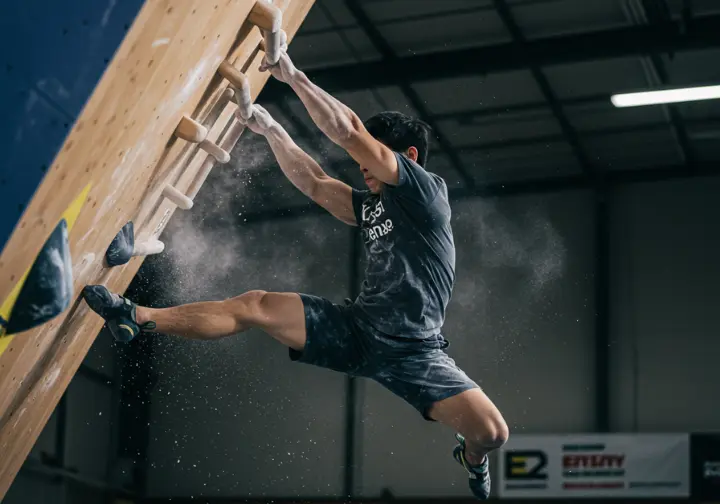
It’s time to bridge the gap between possessing strength and deploying it with speed. We will define climbing-specific power training, explain the crucial concept of Rate of Force Development (RFD), and provide detailed guides to plyometric and specific power exercises. The goal is to transform your foundational strength into the dynamic, explosive movement that defines powerful climbing.
Understanding Rate of Force Development (RFD) and Contact Strength
Rate of Force Development (RFD) is the speed at which a climber can generate force. This is the key differentiator between strength and power. Imagine two climbers who can both perform a one-arm pull-up; they have similar maximal strength. However, the athlete who can generate that force faster will be the one who can execute a dynamic lunge to a distant hold. This is the essence of RFD and a core tenet of modern exercise science programs.
Climbers often refer to this quality as “contact strength”—the ability to grab a hold and instantly apply stabilizing force to it. Scientific evidence backs this up. A compelling study by Stien et al. (2021) provides quantifiable data showing that elite climbers have a significantly higher rate of force development and maximal strength. For instance, at 100 milliseconds, elite climbers generated force at ~1928 N/s compared to ~1146 N/s for advanced climbers. This proves it’s not just about being strong, but about being fast.
A high RFD translates directly to on-wall athletic performance. It is the physical quality that enables powerful dynos, sticking desperate moves at the end of their reach, and moving efficiently on demanding terrain. This is especially true in bouldering and competition climbing. It’s the physiological basis for what climbers feel as “snap” or “pop” in their movements, and it is a key component when you work on developing three key areas: power (explosive force), finger strength… and lock-off strength.
The primary implication for this power training method is that movements must be performed with maximal velocity and intent. A power workout is not about slow, grinding reps. It is about explosive, high-speed efforts with long rest periods in between. This ensures every repetition is of the highest quality, which is necessary to teach your nervous system and Type II muscle fibers to fire more rapidly.
Plyometrics: Training Your Body to Be a Spring
Plyometrics are a training method using explosive movements like jumping and throwing to enhance power output. They work by utilizing the stretch-shortening cycle (SSC). This is where a muscle is rapidly stretched (the eccentric phase) and then immediately followed by a rapid shortening (the concentric phase), much like stretching and releasing a rubber band. This plyometric training process trains the nervous system to recruit muscle fibers more quickly, directly improving your Rate of Force Development (RFD).
For climbers, key upper-body plyometric exercises include plyometric push-ups, often called clapping pushups. To perform them correctly, lower your body under control, then explode upwards with enough force for your hands to leave the ground. You must land softly to absorb the impact and then immediately begin the next rep to effectively train the SSC. For a more detailed look, Healthline covers the benefits, how-to, and variations of this exercise.
Essential lower-body plyometrics include box jumps and jump squats. For box jumps, instruct the user to stand before a sturdy box, dip into a quarter squat, and then explode upwards, landing softly and quietly on the box, with knees tracking over the feet. The goal is explosive upward movement, not just jumping onto a high box with poor form. These drills build the raw power needed to master advanced bouldering techniques: dynos, heel hooks, and toe hooks.
Safety is paramount with plyometrics. These high-impact exercises should only be performed after a solid strength base has been established. They must be done when the body is fresh, typically at the start of a workout. Keep repetitions low (e.g., 3-5 reps per set) and take long rest periods. This ensures maximal quality on every effort and helps prevent injury.
The Climber’s Arsenal: Tools for Strength and Power
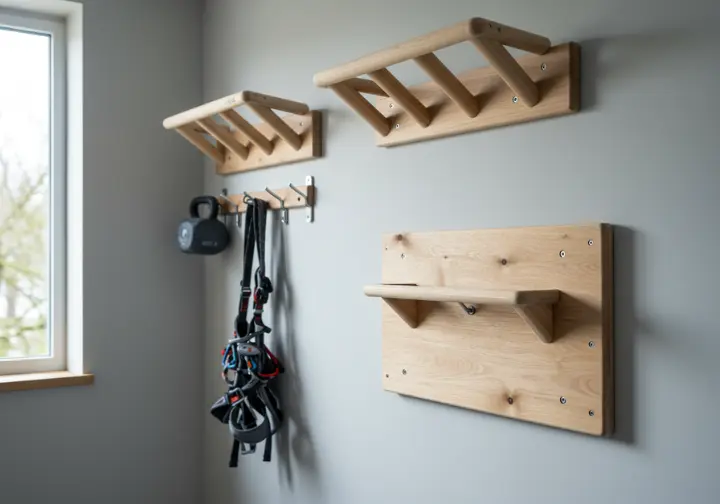
Using the right tools correctly can accelerate your power progress. We will provide a detailed guide to the most common and effective climbing-specific training equipment, covering the distinct purposes of hangboards, campus boards, and system boards. You will learn how to use each tool safely to target the building blocks of high-level performance: finger strength, contact strength, and explosive strength.
Mastering the Hangboard for Finger Strength
The hangboard, or fingerboard, is the single most effective tool for developing maximal isometric finger strength—the ability to hold onto small edges. This is a foundational strength that directly translates to your performance on the rock. While its primary purpose is building this static strength, specific protocols can also be used to target contact strength. It is the central tool in any comprehensive guide to rock climbing finger training.
A great hangboard routine for beginners and intermediates is the “repeater” protocol. A common power workout example is performing a 7-second hang followed by a 53-second rest. Use a comfortable edge (e.g., 20mm) with an open-hand or half-crimp grip. Perform 6 of these hangs to complete one set, and rest 3-5 minutes between sets. It is absolutely vital to engage the shoulders and back, maintaining “active shoulders” to prevent injury.
To continue making gains on the hangboard, you must apply progressive overload. This means systematically making the hangs more difficult. You can achieve this by using smaller holds, adding weight with a harness and free weights, reducing the number of fingers used, or, for advanced athletes, moving to one-arm hangs. This principle ensures you continue to stimulate muscular adaptations.
Safety and proper form cannot be overstated. Always warm up thoroughly before a hangboard session, never train to complete failure, and avoid the full-crimp grip in most situations as it places excessive stress on your finger pulleys. Listen to your body; if you feel any sharp pain in your fingers, tendons, or joints, stop immediately. A good hangboard training guide will always emphasize these safety points.
Using the Campus Board for Explosive Power
The campus board is a tool specifically designed for developing explosive upper-body power, contact strength, and Rate of Force Development (RFD). Invented by climbing legend Wolfgang Güllich to train for his route Action Directe, its purpose is purely for dynamic, powerful movements. It is an advanced training technique and is absolutely not suitable for beginners or even many intermediate climbers.
Strict safety prerequisites must be met before starting campus training. Climbers should have at least two years of consistent climbing experience, be able to boulder at a V6/V7 level, and possess a solid hangboard strength base. Attempting to campus without this foundation poses a very high risk of serious injury to the fingers, elbows, and shoulders, making it one of the most demanding pieces of effective rock climbing training equipment.
Basic campus board exercises include “Laddering” and “Touches”. For laddering, you move up the board one rung at a time, hand-over-hand, focusing on an explosive pull with each move. For touches, you move one hand up to a higher rung and immediately return it to the starting rung. This trains dynamic control and contact strength. Climbing Magazine offers a great guide on how to train on a campus board safely.
Campus training is about quality, not quantity. Sessions must be short and performed when you are completely fresh. You should take very long rest periods (2-3 minutes) between attempts. The goal is maximal power output on every single move you make on the board, not to get pumped. This high-quality focus is what drives the desired neuromuscular adaptations for unmatched strength and power.
System Boards and Limit Bouldering for Specific Power
System boards, such as the Moonboard, Kilter Board, or Tension Board, are a hybrid tool. They bridge the gap between the raw power of campusing and the technical skill of climbing. Their symmetrical hold layout allows climbers to train specific movements and build strength and power in a more controlled, replicable way than random gym boulders. This makes them ideal for targeting weaknesses and developing powerful, precise movement patterns.
These boards are used for power development through “limit bouldering”. This involves working on boulder problems that are at or very near your maximum ability level. These problems are typically very short, often just 1-4 moves. They require maximal effort and explosive power to complete, perfectly simulating the crux sequences found on hard outdoor climbs. In essence, you’re training on a short, specific climbing route designed to push your power limits.
Different system boards offer unique benefits. The Moonboard, for example, is known for its difficult, powerful style and non-adjustable angle, making it an excellent tool for pure power training. In contrast, the Kilter Board, with its adjustable angle and extensive hold selection, offers more versatility for climbers of all levels to train power, strength, and technique. TrainingBeta offers a helpful intro to system board training.
A key advantage of system boards is the ability to train bilaterally. Because the holds are mirrored, climbers can easily set and replicate moves on both their strong and weak sides. This is invaluable for correcting muscular imbalances and ensuring that power can be applied effectively regardless of which hand is leading or which direction the move is going.
Smart Programming: Integrating Power and Strength Exercises

Knowing the exercises is one thing; putting them together into a coherent plan is another. We will now provide the framework for a smart strength program, covering the core principles of periodization, managing frequency, and prioritizing rest. You’ll learn how to adapt your program for different ability levels and climbing disciplines, moving from isolated exercises to a sustainable, effective workout split.
Periodization, Frequency, and Recovery
Periodization is the organization of training into logical blocks or phases. A common approach for climbers is to have a dedicated “strength phase” focused on building a maximal strength base with heavy lifting and hangboarding. This is followed by a “power phase,” where the focus shifts to explosive training work to translate that strength into performance. This structured approach prevents plateaus and reduces injury risk.
For dedicated, high-intensity strength or power workouts, a frequency of two times per week is generally recommended for most climbers. This schedule provides enough stimulus for your body to adapt while allowing for adequate recovery. The physiological gains from your exercising actually occur during these rest periods. This is the foundation of a systematic training approach.
Recovery is a critical, non-negotiable part of any training plan. Overtraining is a major cause of performance plateaus and injuries, as strength training fatigue increases. Climbers must prioritize adequate sleep, nutrition, and rest days. This allows your muscles, tendons, and nervous system to repair and get stronger. Ignoring recovery will quickly negate the benefits of even the most well-designed training program. For expert advice, consider the Lattice training series strength and power.
Integrating these sessions with actual climbing requires some planning. A common weekly structure, like a push/pull/legs routine, might involve two strength/power sessions on non-climbing days, and two or three climbing days focused on either volume or endurance. The key is to avoid performing a high-intensity strength-building workout the day before a planned performance day on the rock or in the gym.
Adapting Training for Bouldering vs. Sport Climbing
To frame the training discussion, it’s important to understand the primary physical difference between the two disciplines. Bouldering is defined by short bursts of maximal power and strength over just a few difficult moves. In contrast, Sport climbing, utilizing pre-placed bolts for protection, requires power-endurance—the ability to perform many difficult moves in a row with limited rest, demanding a greater aerobic capacity and cardiovascular fitness.
A bouldering specialist’s program should heavily prioritize the development of maximum fitness, maximal strength, and explosive power. This means focusing on exercises like heavy weighted pull-ups, heavy deadlifts, campus board work, limit bouldering, and plyometrics. The goal is to maximize the upper limits of force and Rate of Force Development (RFD) to overcome the intense difficulty of individual crux moves.
A sport climbing specialist’s program requires a different balance. While a base of maximal strength is still essential, the program must also include a significant amount of power-endurance training. This involves workouts like 4x4s on a bouldering wall or linked boulder circuits. Training For Climbing offers excellent power endurance training protocols from experts designed to improve the ability to sustain power output and recover between difficult sections.
Climbers who enjoy both disciplines can use a periodized approach. They might focus on building serious strength and power in an “off-season” or bouldering-focused phase, and then shift their training to be more power-endurance focused as they prepare for a sport climbing trip or season. This allows them to peak for the specific demands of their current goal.
Training at Home: Bodyweight Power and Strength Exercises
A lack of access to a commercial gym or specialized equipment is not a barrier to getting stronger and more powerful. A highly effective strength and power routine can be built using only bodyweight exercises and basic household items. This is particularly important for beginners who need to build a solid foundation before using advanced tools. A well-structured home-based rock climbing workout routine is an invaluable asset.
A list of essential bodyweight strength exercises for climbers includes push-up variations for antagonist strength and shoulder health. For pulling strength, inverted rows performed under a sturdy table are highly effective. For lower body power and stability, single-leg squats (pistol squats) and their progressions are excellent. Each of these movements targets key muscles that directly translate to better performance on the wall.
You can also develop power with bodyweight exercises. This requires focusing on explosive movements like jump squats, lunges with a jump, and clapping push-ups. The key to making these exercises effective for power is the intent to move as fast and explosively as possible on every single repetition. This high-velocity effort is what trains your nervous system to be more powerful. The Appalachian Mountain Club provides great examples of a home workout exercises for rock climbers.
To adhere to the principle of progressive overload without weights, you can creatively increase difficulty. This can be done by manipulating leverage, such as elevating your feet for push-ups. You can also progress to single-limb variations, like moving from two-leg squats to pistol squats. Another method is to decrease stability to force greater core engagement and control.
Injury-Proofing Your Power: Safety and Prehabilitation
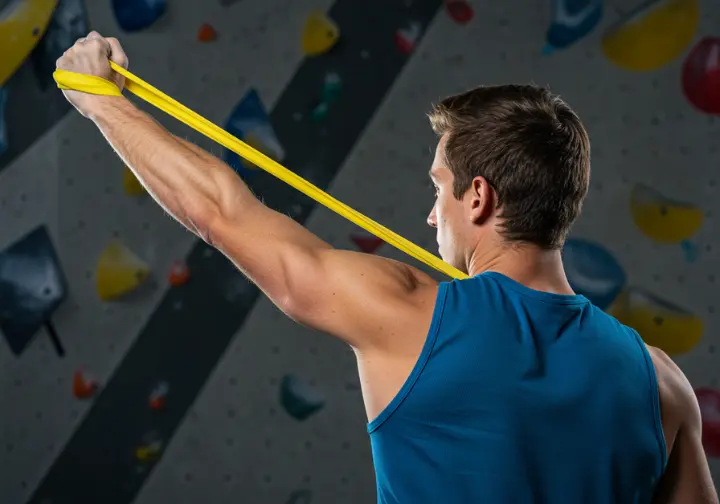
Training for power must go hand-in-hand with a focus on longevity and health. We will detail how to perform exercises with proper form, the importance of a thorough warm-up, and how to manage common climbing-related injuries. We will also cover specific prehabilitation exercises to build a more resilient body, because the strongest climber is one who can train consistently without getting hurt.
The Importance of Proper Form and Warm-Ups
Proper exercise form is the single most important factor for both training effectiveness and injury prevention. Using poor form not only fails to train the intended muscles but also places dangerous stress on your joints and connective tissues. This can lead to either acute or chronic injuries. It is always better to use a lighter weight with perfect form than to attempt a heavier weight with sloppy technique.
An effective warm-up before any strength or power session is essential for injury prevention. A structured approach like the RAMP protocol is highly effective. This involves: Raise (light cardio to increase body temperature), Activate (engage key climbing muscles like the core and rotator cuff), Mobilize (dynamic stretches for hips and shoulders), and Potentiate (light, movement-specific exercises like easy hangs or explosive wall push-ups).
A good warm-up has specific physiological benefits. It increases blood flow, which improves the elasticity of muscles and tendons. It also enhances neuromuscular coordination—the mind-muscle connection—and lubricates the joints. A comprehensive warm-up primes your body for high-intensity work and directly reduces the risk of strains and sprains, with research confirming the effectiveness of dynamic stretching as part of this process.
Common form mistakes can lead to specific injuries. These include rounding the back during deadlifts, letting the knees cave inward during squats, or using momentum (kipping) on pull-ups that are intended for strength development. For each of these, there is a significant injury risk. Simple cues, like “chest up” for deadlifts or “knees out” for squats, can help correct these dangerous patterns.
Preventing and Managing Common Climbing Injuries
Finger pulley injuries are common, with the A2 pulley being the most frequently strained. These injuries are often due to high dynamic loads or uncontrolled movements. Prevention involves building a strong base of finger strength through controlled hangboarding before attempting high-risk dynamic moves on a campus or system board. If you feel sharp pain in a finger, it is a signal to stop immediately.
Elbow tendinopathies, commonly known as Golfer’s Elbow and Tennis Elbow, are overuse injuries. They are often caused by muscular imbalances between the powerful finger flexors and the weaker extensors. These are some of the most common causes like Medial (Climber’s) and Lateral (Tennis) Epicondylitis seen in climbers. Prevention focuses on dedicated antagonist training, like wrist extensions with a light weight or resistance band, and carefully managing your overall training volume.
Shoulder health is paramount, as rotator cuff issues and impingement are very common due to the prevalence of overhead pulling. Prevention requires a dedicated prehabilitation routine that includes strengthening the external rotators of the shoulder. This is easily done with resistance bands. Maintaining good posture and scapular control during all exercises is also vital. You can find excellent resources on climbing shoulder injuries exercises and tips to build a resilient upper body.
The single most important principle of injury prevention is learning to listen to your body. You must learn the difference between the general discomfort of muscle fatigue and the sharp, localized pain of a potential injury. Prioritizing rest and recovery over pushing through pain is the absolute key to a long and sustainable climbing life.
Key Takeaways: Your Path to Power and Strength
The path to becoming a more powerful climber is built on a simple, core principle: build a wide base of foundational strength before chasing high-intensity power. This is the safest and most effective path to long-term, sustainable improvement.
Remember that power is fundamentally about speed. To train for power and improve your Rate of Force Development (RFD), you must perform explosive exercises with maximal intent and velocity on every single repetition.
Ultimately, correct form and consistency are more important than the complexity or volume of your training. Master the basics of the key lifts and bodyweight movements. Listen carefully to your body’s signals, and prioritize recovery to prevent injury and make consistent gains over time.
We encourage you to start small. Identify one or two key exercises from this article that target a perceived weakness and begin integrating them into your weekly routine. Use this knowledge as a foundation for your skill development, and explore the other resources on our site to continue your journey toward becoming a well-rounded, knowledgeable, and powerful climber.
Frequently Asked Questions about Power and Strength Exercises for Climbers
How many times a week should I do power and strength exercises? +
Will strength training with weights make me too heavy for climbing? +
What is the most important type of strength for a beginner to focus on? +
How can I measure my progress in strength and power? +
We are a participant in the Amazon Services LLC Associates Program, an affiliate advertising program designed to provide a means for sites to earn advertising fees by advertising and linking to Amazon.com. As an Amazon Associate I earn from qualifying purchases. We also participate in other affiliate programs. The information provided on this website is provided for entertainment purposes only. We make no representations or warranties of any kind, expressed or implied, about the completeness, accuracy, adequacy, legality, usefulness, reliability, suitability, or availability of the information, or about anything else. Any reliance you place on the information is therefore strictly at your own risk. Additional terms are found in the terms of service.



